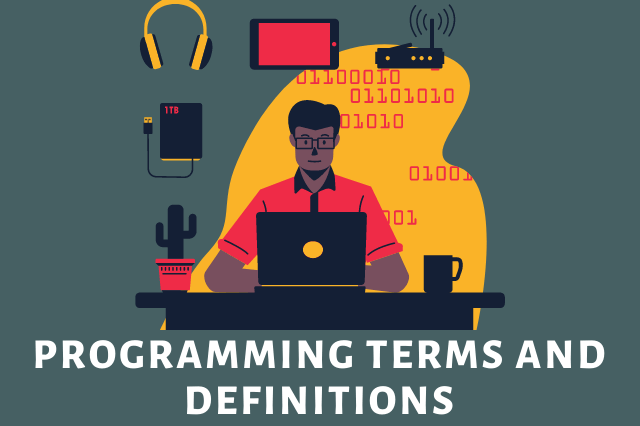Hello programmers, welcome to Techpass Master. In this post, I’ll share with you the top Programming Terms and Definitions. If you’re a beginner programmer, so this post is for you. All the terminology we run into as programmers can be overwhelming and a little intimidating.
I’ve put a list of definitions that I feel every programmer should know. If there are any you feel, I missed, be sure to leave them down in the comments below the post with the definition.
Page Contents
Programming Terms and Definitions for Beginners Programmer

Below I’ve put together a list of Programming Terms and Definitions:
• ASCII
The American Standard Code for Information Interchange (ASCII) is a system for electronic communications. It has 128 numbers that stand for either a letter of the alphabet or a symbol. ASCII is a standard that’s the same all over the world.
• Data Structures
The Data structures are a specialized, specialized means of organizing and storing the data in computers. Examples of data structures are linked, lists hash maps, and binary trees.
• Algorithm
The Algorithm is simply a set of steps to use to complete a specific task and they help us to add logic & decision making to the program.
• API
API stands for Application Programming Interface. It’s a set of actions defined by a system or program and programs can use the API to retrieve data or perform some type of action.
• Array
The Array is a data structure consisting of the collection of elements stored contiguously in memory. Arrays are known for their simplicity and the ability to quickly retrieve and update elements.
• Big-O
The Big O notation is used to classify algorithms according to how their runtime or space requirements grow as the input size grows it gives an idea of how fast or slow or how much space an algorithm takes as the input size grows.
• Compiler
The Compiler is a computer program that translates code within one programming language into another language. Compilers are commonly used to translate code from a high-level programming language to a low-level programming language like machine code.
• Bit
The bit is short for binary digit a basic unit of information used in computing a bit can have one of two possible values usually either a zero or one.
Byte
byte a unit of digital information that most commonly consists of eight bits. It is the smallest addressable unit of memory in most computer architectures.
• Debugger
A debugger is a tool that allows you to set breakpoints in your code which you can use to step through each line and find exactly why and where the bug is occurring.
• Executable
Executable a program that contains a set of instructions and machine code.
• Garbage collector
The Garbage Collector attempts to reclaim memory that was allocated by the program but is no longer being referenced. It was introduced to simplify manual memory management to minimize potential memory leaks.
• IDE
IDE or Integrated Development Environment is a program that takes common developer tools and combines them all into one single application an idea normally consists of at least a source code editor a necessary compiler or interpreter and a debugger some ids also contain a version control system.
• OOP
OOP – Object-oriented programming is a programming paradigm based on the concept of objects which contain data in the form of fields or properties and actions in the form of procedures or methods.
• Open-Source
The open-source software that’s free for anyone to use the code open-source software is available to developers who want to work on it they can make improvements and add features.
• Recursion
Recursion is simply a function that calls itself that can be done iteratively can be done recursively but beware because this makes your code susceptible to a stack overflow error generally recursive methods are more elegant than iterative ones and require less code.
• Virtual Machine
A virtual machine is a virtual environment that functions as a virtual computer with its CPU memory and storage typically it’ll be an operating system that sits on top of a logical instance of hardware hosted on a physical device.
• Function, Method, and Procedure
The combination of function, system, and the procedure is a sequence of program instructions that perform a specific task packaged as a unit, this unit can be used in programs wherever that particular task should be performed.
• Machine Code
The Machine code is any low-level programming language conforming to machine language instructions to control a computer CPU, each instruction causes the CPU to perform a specific task on one or further units of data in the CPUs registers or memory.
I’ll add some more Programming Terms and Definitions soon. Stay tuned with Techpass Master.
I hope you liked the post. If you have any questions regarding this post. Feel free to comment and share the post with other programmers.
Happy Learning!!!
You May Also Like:
- How To Change Font On Facebook.
- How To Increase Followers On Instagram For Free 2021.
- 15 Best Useful Sites For Online Learning.
- How To Upload An HTML Website On The Internet [Step By Step].
- Kotlin tutorial for beginners.
- Kotlin Android Math App In Android Studio.
